Shorten your reins!
I’ve heard that my entire riding life. On the most basic level, your hands hold onto the reins, the reins attach to the bit in the horse’s mouth, and how you move that bit tells the horse what you want them to do. Turn left. Turn right. Stop.
Although that tug on the reins might work for a dude on a trail ride, for those of us whose aim it is to mind meld with our horses, it’s far more complicated. That communication to your horse via the bit doesn’t start with your fingers on the reins. It goes further back to the angle of the wrists, the bend in your elbows, your shoulder joint (which should be as elastic as the horse’s gaits.) How your horse responds to the bit is affected by your back, upright and independent of your limbs, and how your sitting bones are placed in the saddle. Ultimately, that conversation through the bit starts with your mind. Your focus and intention is communicated through all of your body. Some of it is funneled to the bit in the mouth, which is only a small part of that conversation, but it’s one that used tactfully can add depth and finesse to the discussion; used unskillfully, it can detrimentally change the tone of that communication to one that is oppositional.
When a horse softens into contact with the bit you can converse in a subtle way. For example, if I close my ring finger onto the rein and tip my wrist a half-inch, Tonka will arc in that direction. That “feel” of elasticity between your hand and the horse’s mouth can be elusive. It can take years to develop. It takes athleticism and precision and restraint on your part. It takes listening and tolerance from the horse. When you do have that “feel” in the bit, it’s like your thoughts carry through your body to your hands and directly to your horse’s mind. Not only does your horse go where you want, but they do it in a more beautiful way. Your horse’s strides become more expressive. Their back rises up to meet you. Tension dissolves into flow. It’s marvelous.
Unfortunately at that very moment of glorious mind-meld, many riders, myself included, have the inclination to let the reins slip out of our fingers. I’ve been taught (rightly so) to reward the moment that a horses accepts that feel by softening your contact. Rather than let those reins get long, what you want to do is keep the contact but soften your muscles. When teaching riding, I can often improve the partnership of horse and rider by simply saying “relax the tension in your forearms.” That sends a positive message to the horse without letting those reins slip. Why are long reins such a problem? Because it’s impossible to have an immediate connection when your hands are in your lap and you have to pull your elbows back to feel any contact. Like in this photo. I’m about to lose that feel. See how far back my right elbow is? And how my left wrist has twisted and lowered in order to maintain contact with the bit? I can keep Tonka in a trot like this, but transitions are going to be messy!
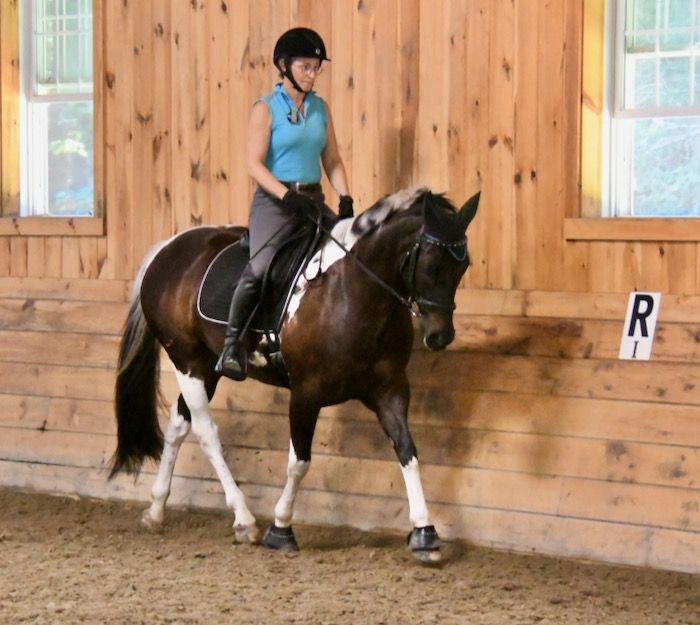
I’ve had difficulty keeping my reins short while learning to jump. This is due, in part, because I do not want to yank Tonka in the mouth as I learn how to balance over the obstacles. Especially since he’s shown such enthusiasm, and I have to be ready for big leaps like this. I try to grab mane, but my body is not so good at staying folded over the jumps, and I let the reins slide out of my hands rather than pulling on his mouth.

I could just let go of the reins, point Tonka at the jumps, and let him do his own thing. He won’t stop. But if my reins are long, I can’t slow him down, or tell him, for example, when he needs to do six strides between jumps, not five. Here I’ve let my reins get too long after the first jump, so that by the time I gather them up and try to talk to Tonka, he’s flying at the second obstacle and it’s awkward, to say the least.
When I do manage to not let go of the reins after the first jump, the picture is less dramatic. Six strides. There’s less of a chance of me yanking Tonka in the mouth when he jumps at the appropriate height from the right distance!
Just because you know the right thing to do, doesn’t mean that you can physically do it. I knew where I needed to keep my hands on the reins, but I couldn’t seem to keep my hands closed around them. Steph kept saying shorten your reins. But by the time I heard and registered that, Tonka would be another three strides down the line. When I looked at my reins to adjust the length, all I saw was a long brown strip of leather. I couldn’t decide how short to hold them while cantering along. Instead of steady, smooth contact, poor Tonka was putting up with me alternating between me tugging on his mouth, and letting the reins flap. I needed to do something.
Out came the gaffer tape. This tape doesn’t leave a sticky residue. I could put it on my reins to mark where my hands are supposed to be without harming my lovely leather bridle.
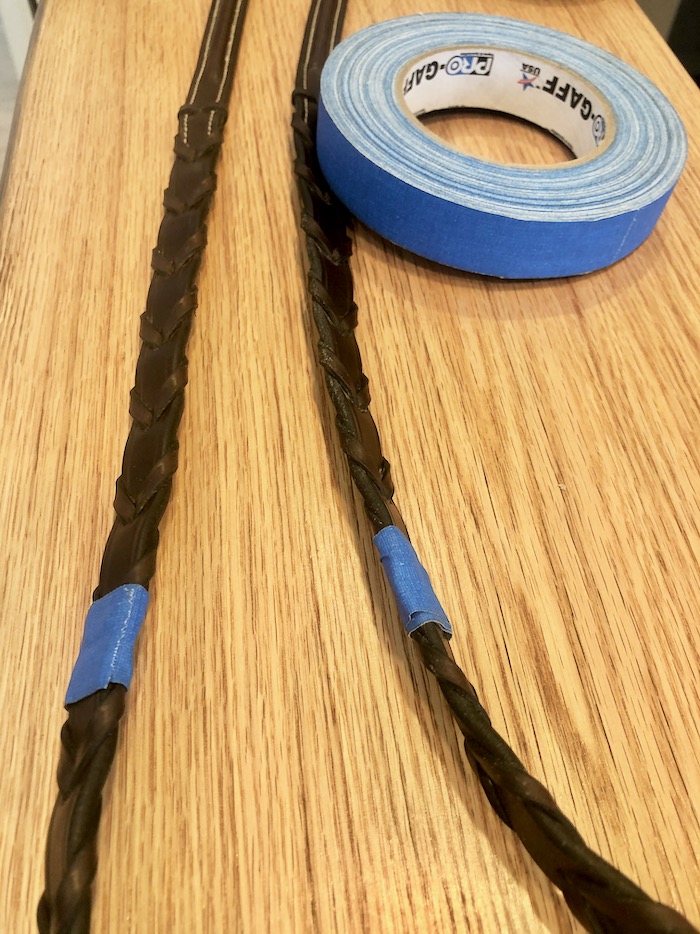
Now, all Steph has to say is reins!, and I can quickly glance at where the blue strip is and close my hands there.
It’s working! Coming into the jumps I don’t have a dangling loop in the reins, but Tonka still has enough room to move.
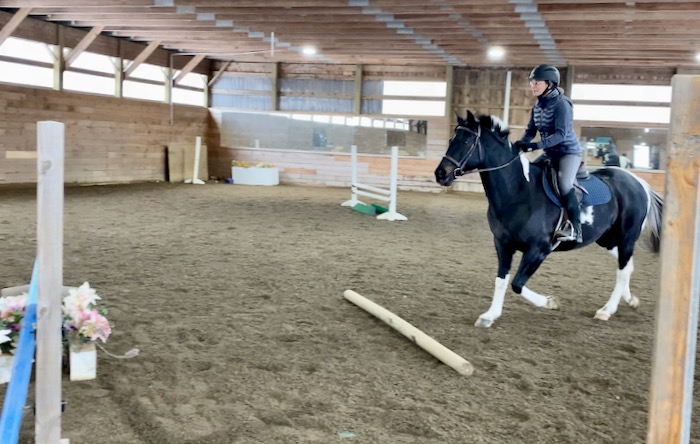
Over the jump we’re in sync, and when I land I can quickly reorganize myself as we head to the next obstacle.
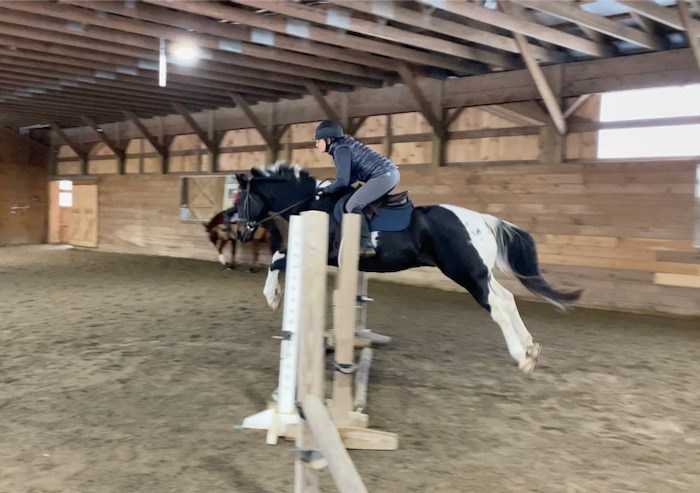
At some point my muscle memory will kick in and keeping my hands closed on the reins at the right place will become second nature. But until then, you’ll see me riding with blue tape.
Just a side note: There are plenty of times that I ride Tonka on the buckle (reins held loosely at the furthest point from the mouth.)
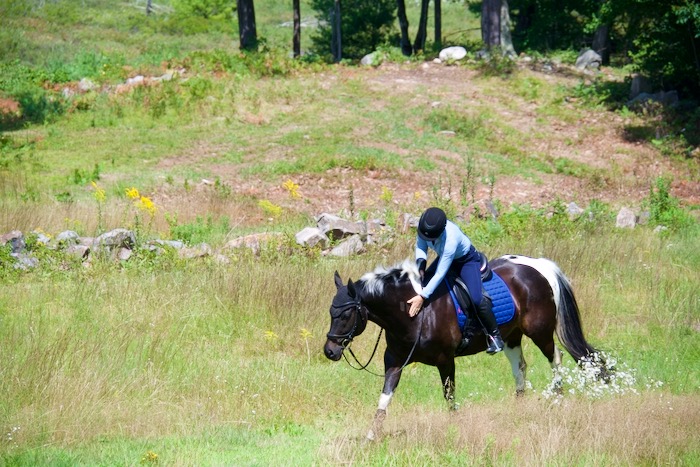
I also have no objections to bitless bridles – although even when those are worn the horse still appreciates soft contact and not having the rider grabbing for the reins. For me, for the sort of immediate, subtle and clear communication that I strive for in my chosen horse sports of dressage and jumping, I’ll keep working on perfecting that contact with the bit, and I’m not embarrassed to use colorful tape to get there.


You do a great job communicating a sense of an elastic contact.
Those “feel” issues make riding so fascinating, in between frustrating and very rewarding depending on the day. 🙂
Sometimes depending on the side of the ring you’re on! 🙂
Keeping a slight contact but not getting into their mouths seems to be an ongoing learning process. I ride western, one handed, but I still like to have soft contact. Actually I use my legs and seat for a lot of directions. Sometimes we relax and let the reins loose. I like the idea of the tape. Wish I would have had that way back when I was teaching my nieces to ride.